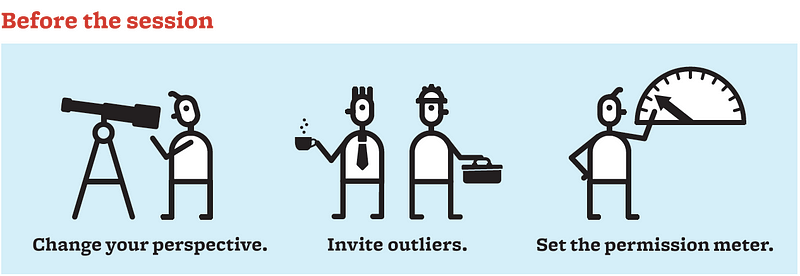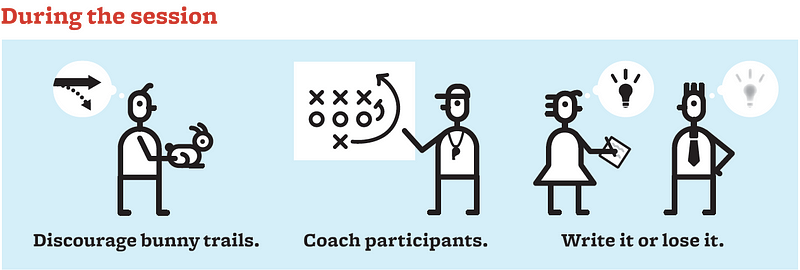Brainstorming — that go-to tool for rapid ideation — can yield mixed results. When it works, team members build on each other’s comments, producing more promising ideas than one person alone. When it fails, you get ideas that are too far out or totally lackluster — and team members who are frustrated and dejected.
However, the key to an effective session is counter-intuitive. While brainstorming appears to be free flowing and organic, your session will be more fruitful if you plan and structure it.
Use brainstorming at the start of a project, when you need a lot of ideas fast, or later on, if you need alternative solutions. Don’t use brainstorming to
give critiques or make decisions.
Here are some tips to get ideas brewing and engage participants.

Prepare questions in advance. People spark more ideas when they’re forced to focus, so plan specific prompts. “How can we get each customer to spend $10 more at each visit?” is stronger than “What are your ideas for increasing revenue?” Another way to ignite ideas is to take a different perspective. Instead of “What services should we include in our carwash?” ask “What would a soccer mom want from a carwash?”
Plan your time wisely. To create urgency and keep the group engaged, chunk a one-hour session into three to six topics, and set a time limit for each topic. Prepare several questions per topic in case the group gets stuck.
Curate your group. Invite people to your session who have varying backgrounds, personalities, and subject matter knowledge. Work with engineers only? Ask your receptionist to join. Three to ten people are best, but if you have more, break into two or more groups that can attack different topics. People need to feel like they can speak freely, so it might be wise to ask the boss to take more of a listening role.
Set goals and expectations. Before you begin, provide context. Why is everyone here? What do you hope to accomplish? What will happen after this meeting? Remind participants that your goal is to generate scads of ideas — not to critique or choose. Next, set the “permission meter.” On a one-to-ten scale from highly practical to blue-sky thinking, where should your ideas land? Developing concepts for a child-friendly gaming app might score a nine, while discussing ways to reduce traffic accidents at a busy intersection may net a two.

Dynamically manage sessions. Choose a neutral facilitator to keep the group on time, on topic, and moving at a comfortable speed. Your facilitator should watch the time but be flexible enough to switch topics or rearrange the small groups when the pace of ideation slows. He or she should know when to let an especially productive session run long or when to create additional prompts for a particularly fast group.
Help participants articulate their ideas. Facilitators should encourage participation by saying, “Yes. And…” or asking “What else?” Ask them to rephrase foggy ideas until they are clear. They can also reframe questions to keep ideas flowing and cut off rants or off-topic “bunny trails” before they sidetrack the group.
Document every idea. Capture every idea on an index card, whiteboard, sticky note, or easel pad. Try to get each person to write his or her own ideas. Capture ideas completely — aim for eight to ten words — otherwise you won’t remember what they mean later. Schedule a follow-up session to sort, rank, test, and otherwise evaluate the ideas.
First published in Design Goggles, our seven-part series in TEQ Magazine.

